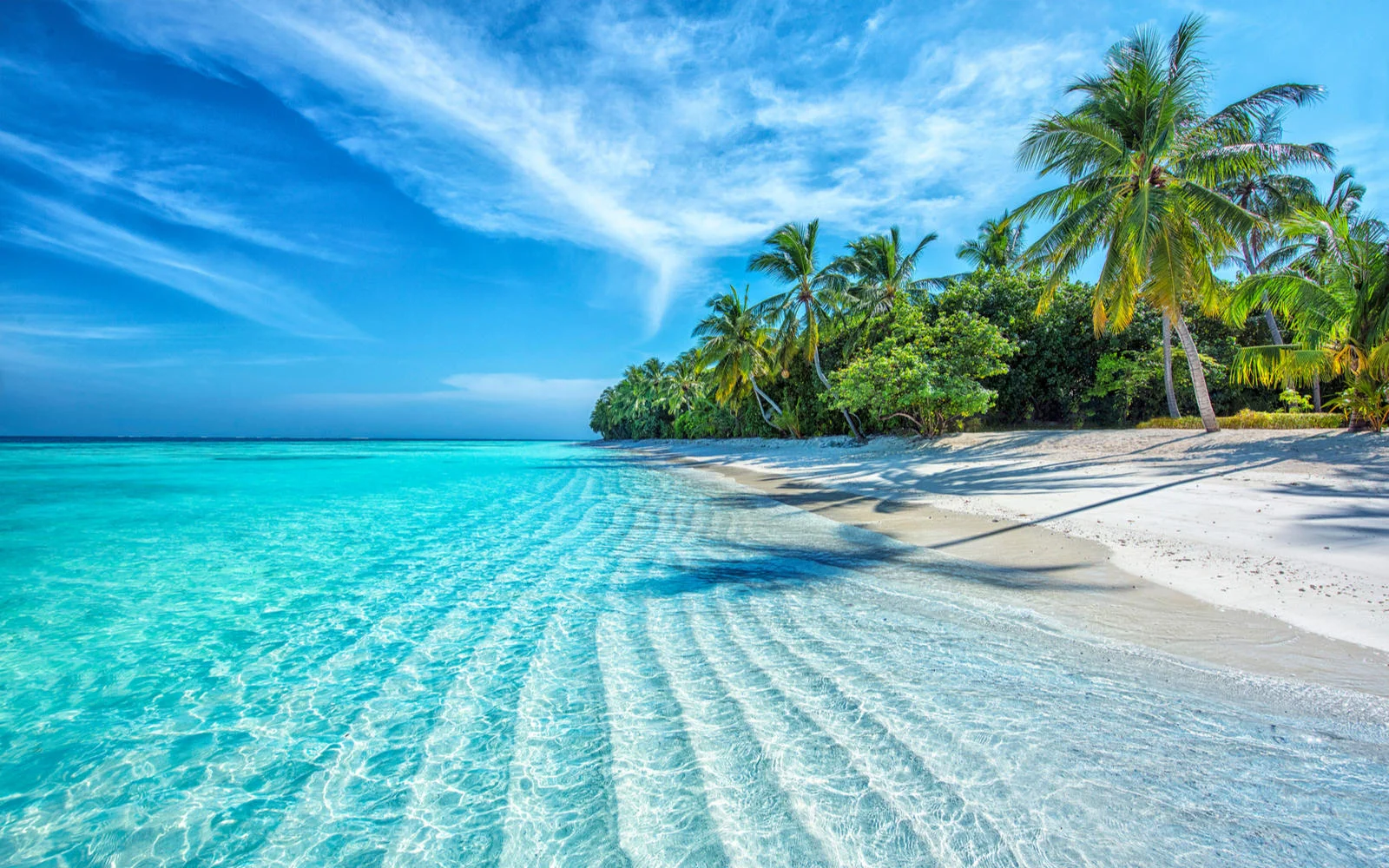What are the safest islands in the Caribbean?
Most Caribbean islands are safe for tourists, with violent crimes typically occurring among individuals who know each other rather than targeting tourists. The safest islands in the region, boasting good safety records and infrastructure for visitors, are Anguilla, St. Barts, Martinique, The Caymans, Abacos in the Bahamas, Aruba, and St. Lucia.
The safest islands in the Caribbean offer a tropical, laid-back getaway without being worried about your safety, theft, or violence. While there are some islands in the region that have a less-than-stellar reputation for safety, a few stand out with very low crime rates, peaceful, friendly atmospheres, and welcoming locals.
When you’re looking for the safest islands in the Caribbean to visit, you have to consider a range of factors that contribute to an island nation’s overall safety level. We look at current travel advisories and localized crime types and rates to determine which islands are safe to visit — and which ones can potentially put travelers at risk.
Let’s explore the 7 safest islands in the Caribbean to consider for your trip and take a look at the measures you can take to keep yourself safe no matter where you travel!
How Do You Know an Island Is Safe?
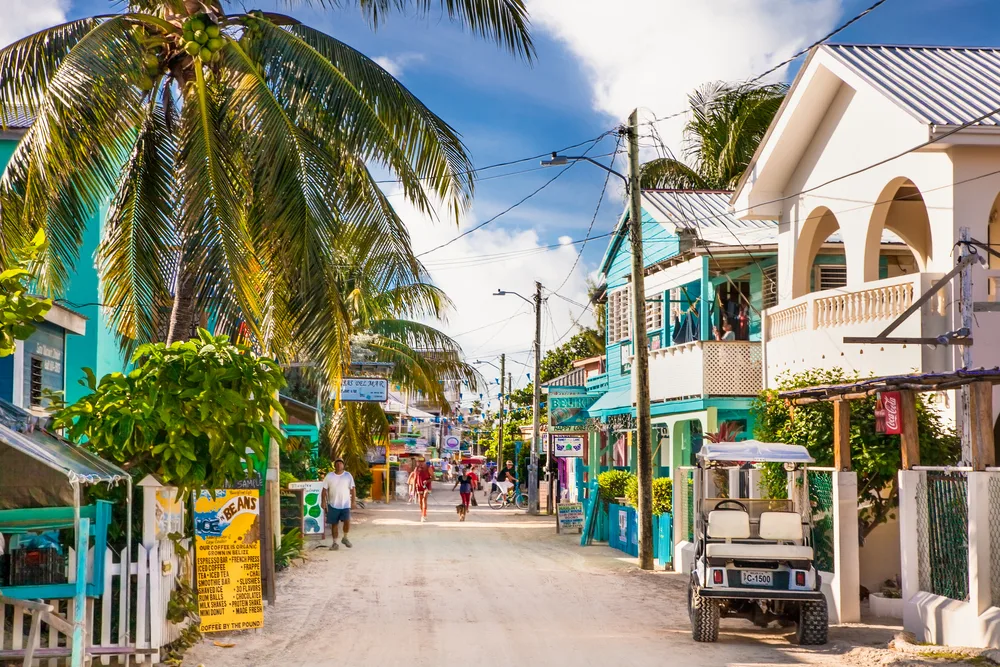
CAYE CAULKER BELIZE – DEC 18 2015: Playa Asuncion street at Caye Caulker island on Dec 18. 2015 , Belize, Central America/Aleksandar Todorovic/Shutterstock
The safest Caribbean islands to visit are those with a level 1 travel advisory from the U.S. Department of State, which tells travelers to exercise normal precautions. Anguilla, Antigua & Barbuda, Aruba, Barbados, Grenada, Martinique, St. Barthélemy, Saint Lucia, and the Cayman Islands are examples.
Caribbean countries with level 1 travel advisories aren’t completely free from crime and safety risks. Every country you travel to will expose you to some level of risk, whether it’s pickpocketing, violent crime, or severe weather. That’s why even level 1 advisories instruct you exercise normal precautions.
Right now, Haiti is the only Caribbean country with a level 4 (do not travel) travel advisory issued by the U.S. State Department. Outside of Haiti and its higher violent crime rates, there are many Caribbean islands that are still very safe to visit.
Some island countries in the Caribbean are currently under a level 3 advisory (reconsider travel), like Jamaica and Trinidad and Tobago. There are a few Caribbean nations with level 2 travel advisories (exercise increased caution), like Belize, Costa Rica, and the Dominican Republic.
You’re certainly going to be safer on islands where crimes don’t often happen to tourists, and where the most-reported crimes are property crimes that are non-violent.
But it’s important to note that Caribbean travel advisories and crime ratings can be skewed by higher crime rates in certain parts of one city on the island. A level 2 travel advisory may steer you away from visiting an island when only a small area (usually outside of tourist zones) is experiencing higher crime rates.
I visited Belize in 2011 and kayaked underground rivers, lounged on the beach, and enjoyed some of the most delicious seafood and Caribbean fare along the way. Belize was (and still is) under a level 2 travel advisory then, but since I stuck to the tourist areas and didn’t venture into dangerous parts of Belize City, it didn’t feel unsafe to me whatsoever.
All things considered, you should always check the most recent U.S. State Department Travel Advisories online before you travel to the Caribbean (or anywhere around the world). Conditions are constantly evaluated for traveler safety so you can get the most up-to-date information on how safe it is to travel.
Next, we’ll take a close-up look at the safest Caribbean islands to visit and what makes these paradisiacal destinations a good choice for security-smart travelers.
Key Points
- Most Caribbean islands are safe to visit. With the exception of Haiti (level 4 travel advisory) and islands like Jamaica and Trinidad and Tobago (level 3 travel advisory), most Caribbean islands are safe for tourists who stick to tourist areas and exercise normal precautions.
- Don’t write off countries with level 2 advisories. While visiting Caribbean islands with the lowest (level 1) travel advisory is preferable, some countries with level 2 advisories are only under these categories due to higher crime in concentrated areas not frequented by tourists (the Bahamas is an example).
- Always take precautions when you travel. You should take precautions wherever you travel, even on Caribbean islands that aren’t under a heightened travel advisory or safety risk. Don’t go out alone at night, don’t leave tourist areas, don’t carry valuables, and avoid sharing info about your hotel with strangers.
The 7 Safest Islands in the Caribbean in 2025
Not only are there plenty of safe islands to visit in the Caribbean, but they’re also beautiful, tropical destinations that offer clear, sunny skies, refreshing, turquoise waters, and endless aquatic adventures. Let’s take a look at the 7 safest islands in the Caribbean so you can start planning your getaway without worry!
1. Anguilla
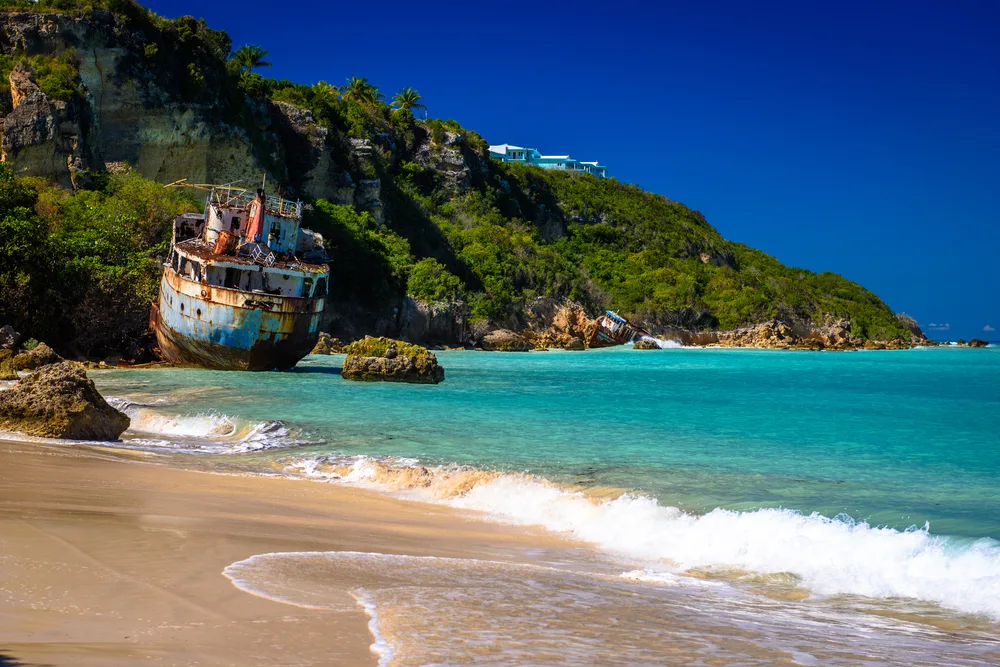
Kristopher Kettner/Shutterstock
Anguilla consists of a main island and a few smaller, offshore islets that boast some of the Caribbean region’s best beaches, from secluded coves to popular shores that attract thousands of tourists. It’s one of the safest islands in the Caribbean to visit with its small-town feel and very low crime rates.
Tourist areas, like West End and Sandy Ground (mid-island), are very popular with tourists. You’ll find a family-friendly atmosphere with more high-end restaurants and resorts concentrated on the western end of the island. Things are less developed with more natural beauty on the East End.
You can relax and enjoy the tropical scenery, great Caribbean food, and long days adventuring on the water or hiking to caves in Anguilla without worry. Still, Anguilla does experience some crime — but at very low levels, especially for the region.
Crime data and statistics aren’t as robust for Anguilla as in other parts of the world. Most of the crime in Anguilla appears to be related to property crime and sporadic youth gang activity.
The rare occurrences (3 cases in 2022) of gun violence shouldn’t be ignored, but it’s not likely to affect tourists visiting Anguilla for sunny days on the beach, glitzy resorts, and water sports.
The U.S. Department of State notes that U.S. citizens aren’t targeted by criminals here, but you should be alert and take precautions to avoid these types of crimes:
- Vehicle break-ins
- Burglary
- Petty larceny (pickpocketing, purse snatching, etc.)
Violent crimes, like robbery, sexual assault, and murder, are not common occurrences here. That’s a large part of what makes Anguilla such a safe island to visit.
A final safety consideration to take is severe weather. While Anguilla faced damage and a single casualty from Hurricane Irma in 2017, there have been 16 hurricanes that hit the island since the 1950s with an average of 1 hurricane every 5 years.
Most hurricanes occur in September and October, so if you’re planning a visit, you may want to avoid these months or the broader hurricane season for the region from June to November.
2. St. Barts
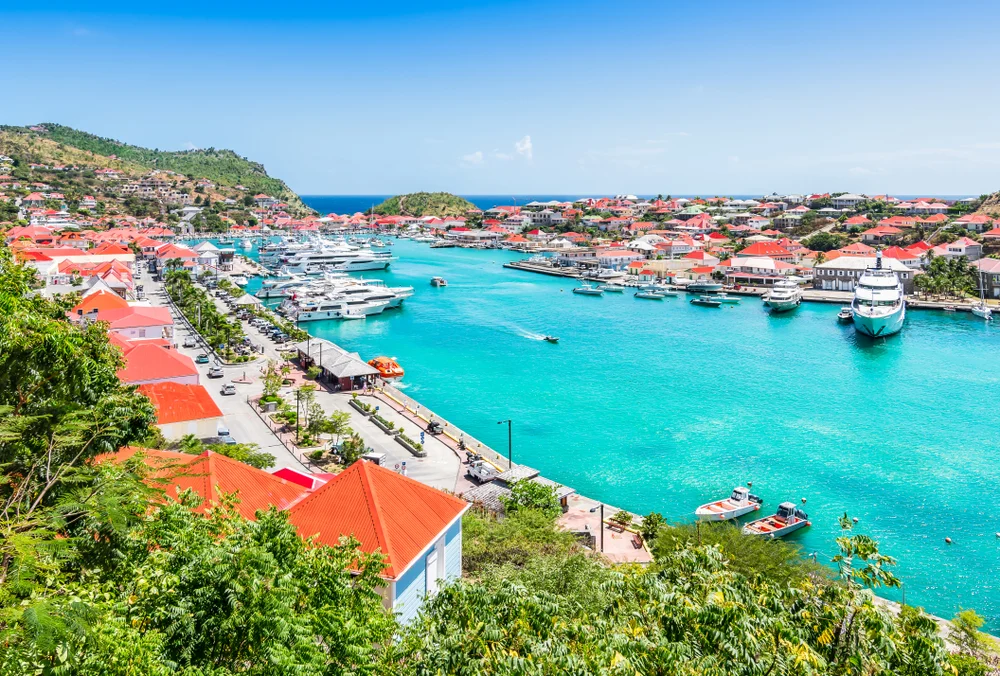
Nanzy Pauwels/Shutterstock
Saint Barthélemy, or St. Barts, is a French collectivity in the Caribbean that is renowned for not only its safety, but also its sparkling, white sand shores and a high-end sophistication with many glamorous resorts, villas, and restaurants populating the island.
When you’re visiting St. Barts, you’ll be able to dine on Caribbean and French fusion cuisine, visit the historic Fort Karl on a hilltop overlooking Gustavia, the capital, and enjoy lazy or adventurous days at Shell Beach or St. Jean Beach without concern for your safety.
You may have seen claims online of St. Barts 0 per capita homicide rate, and while we couldn’t verify that information through any official channels, it’s commonly known that the island doesn’t see much violent crime (including robbery, assault, and homicide).
The U.S. State Department has maintained a level 1 travel advisory (exercise normal precautions) for St. Barts and the other French West Indies islands, because crime here is so rare and non-violent. You can relax and enjoy the scenery when you visit this luxury vacation spot in the Caribbean!
When crimes do occur on St. Barts, they don’t often target tourists and when they do, they’re usually property-related petty crimes, like:
- Petty larceny (pickpocketing, purse snatching, etc.)
- Sale of counterfeit goods
Locals are known to leave their cars and homes unlocked, trusting fellow islanders because of the long-time low crime rates. But if you’re visiting and want to take your personal property and security seriously, you should always take the added step of securing your belongings and hotel room or villa.
St. Barts keeps its reputation as a safe and welcoming island by keeping its accommodations for tourists pretty exclusive and limited. There aren’t many hotels on the island, and many people choose to stay in luxury rented villas, which may be even more secure and safe for tourists than hotels.
Hurricanes can put you at risk anywhere in the Caribbean, including on St. Barts. Thankfully, hurricanes here don’t usually make landfall and skew north before hitting the island. There are around 5 hurricanes annually near the island from June to November, the Caribbean hurricane season.
Another safety consideration to take is access to medical care in the event of an emergency. St. Barts doesn’t have an international airport and there’s only 1 hospital, Hôpital de Bruyn. You may need to be airlifted to Martinique, St. Martin, or even the U.S. in the event of an emergency, so keep this information in mind.
Read Next: When to Visit St. Barts in 2025
3. Martinique
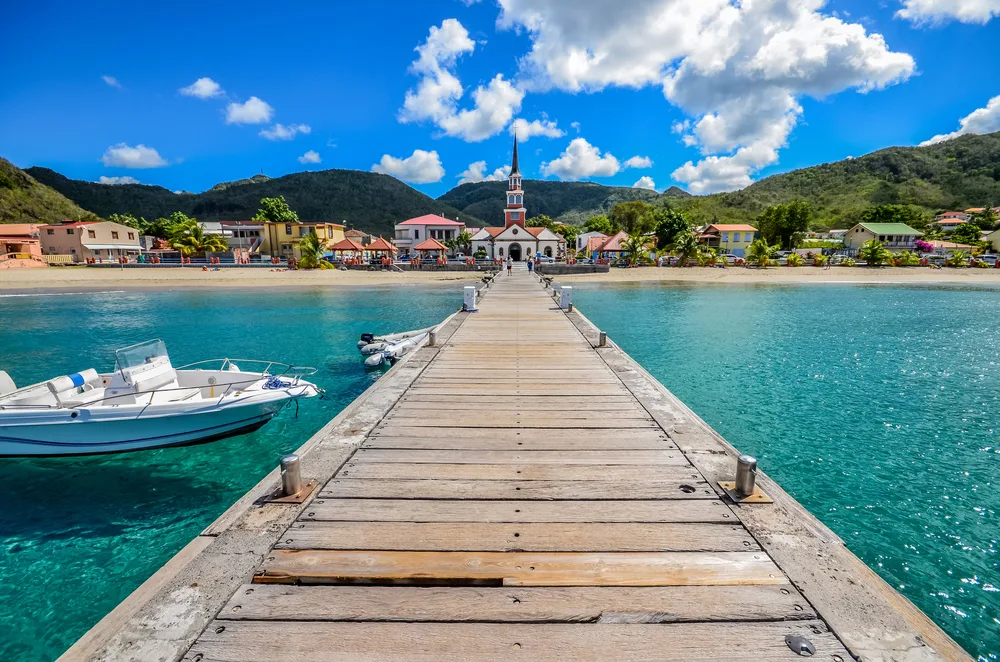
Damien Verrier/Shutterstock
Also part of the French West Indies, Martinique is located in the Lesser Antilles and stands as one of the safest Caribbean islands to visit with very low levels of crime. It boasts rugged and scenic landscapes with idyllic beaches and charming towns for tourists to explore.
Fort-de-France is the island’s biggest town and where most tourists will spend their trip. Gardens, cafes, and quaint, winding streets are part of the charm here, but you’ll probably come for the palm-fringed beaches backed up by lush hills and banana plantations.
You’ll enjoy a laid-back, rejuvenating trip on Martinique without concern about violent crime or the need to constantly be on alert. Crime is rare on the island, with most of the crime on Martinique being property-related and non-violent.
Some of the potential crimes to be aware of on Martinique include the following, noted by the U.S. State Department as uncommon:
- Fraud
- Vehicle break-ins
- Petty theft
- Sale of counterfeit goods
While crimes like these can and do occur on a rare basis, they are the exception and not the rule. That’s why Martinique enjoys a low level 1 travel advisory from the U.S. Department of State and lands on our list of the safest Caribbean islands to visit.
But as we’ve noted for other island countries, crime isn’t the only safety factor when you’re visiting the Caribbean. Hurricanes and access to medical care should be considered for your overall safety.
Fortunately, hurricanes making landfall in Martinique are rare during the June-November hurricane season due to the island’s location in the Caribbean. Like St. Barts, hurricanes that get close to Martinique tend to turn north before hitting the island.
Emergency medical care is easy to obtain with multiple hospitals that have fully-staffed, state-of-the-art emergency care and intensive care units should you need these services while you’re visiting the island.
4. The Cayman Islands
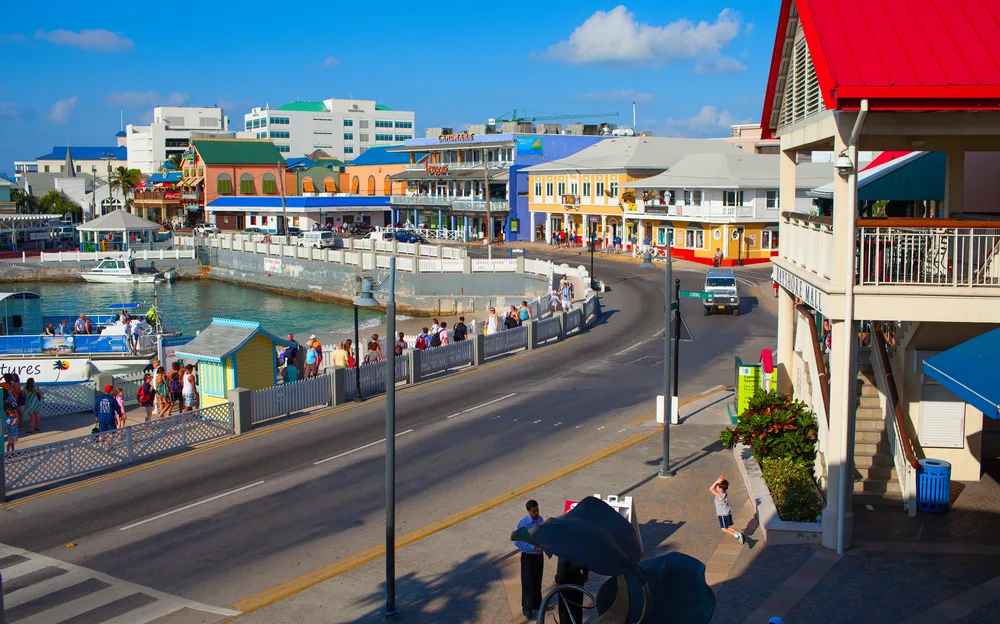
GRAND CAYMAN, CAYMAN ISLANDS – FEBRUARY 21, 2012: Famous island with little colorful buildings and various shops attracting thousands of tourists every day/Yevgen Belich/Shutterstock
The Cayman Islands include Grand Cayman, Cayman Brac, and Little Cayman. These islands rank as some of the safest in the entire Caribbean region with low violent crime rates and absolutely breathtaking scenery and wildlife for visitors to enjoy.
The Cayman Islands sit in the western Caribbean, with Grand Cayman attracting the most visitors with its luxury resorts and excellent diving locations. Cayman Brac and Little Cayman are popular fishing and wildlife havens, home to colorful creatures like blue iguanas, red-footed boobies, and sea turtles.
You’ll be delighted to know that visiting the Cayman Islands is perfectly safe with almost no violent crime plaguing the island or creating cause for concern.
Grand Cayman is so used to its low-crime bliss that a singular week in 2022 with 2 homicides was considered “crime wave” and a swift response from the local Tactical Firearms Unit quickly restored peace and order to the community.
Still, crime happens everywhere and on the Caymans, petty crime is more common than any type of violent crime. Some of the most common crimes that occur (though still considered uncommon) are:
- Petty theft/larceny
- Possession of illegal drugs/firearms
The U.S. State Department notes that the Caymans “are a safe place with little criminal activity targeting tourists” and bestows a level 1 travel advisory, the lowest level out of 4, for the group of 3 islands. This is another indicator that the Cayman Islands are a safe place to visit in the Caribbean.
Although tourists are very rarely the target of crime, including property and violent, homicides do occur here. It’s rare and the rate has continually decreased since 2010, but the most recent homicide rate (2022) sits at around 7.99 per 100,000 people.
Some parts of the islands are safer than others. Sticking to the main tourist and resort areas is your best bet no matter where you go, but it’s prudent to avoid or take extra precaution in areas known for slightly higher crime rates on Grand Cayman, like downtown George Town and areas of the West Bay.
Hurricanes can be a cause for concern between June and November on the Cayman Islands. Though hurricanes happen around 4 times annually here, many do make landfall and can create safety risks with power outages, structure damage, high winds, and flooding.
As an anecdote, during my first visit to Grand Cayman, I ordered a crab dish from a street vendor and enjoyed every bite — but got food poisoning that ruined my next few days of the trip. My advice? Don’t buy seafood from vendors and stick to restaurants!
Read Next: The Best Time to Travel to the Cayman Islands in 2025
5. Abacos Islands, Bahamas
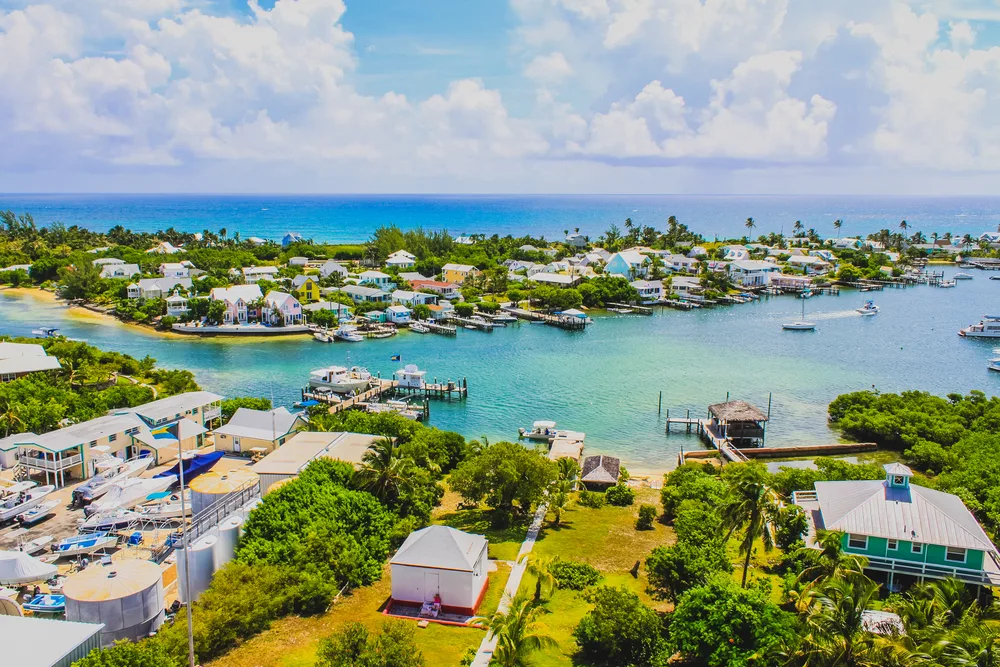
Sinn P. Photography/Shutterstock
It might be an unexpected entry on a list of the safest Caribbean islands to visit because we’re not talking about the Bahamas as a whole, but the Abacos Islands in the northern region of the archipelago are one of the safest parts of the Caribbean to visit.
While Nassau and Freeport have their fair share of crime involving both tourists and locals, the Abacos Islands don’t have that issue. These more-secluded islands are popular dive sites for tourists with coral reefs, sea caves, and abundant marine and wildlife to spot.
Sailing, boating, fishing, snorkeling, diving, and spending long, lazy days on the pristine shores are musts on any trip to the Bahamas’ Abacos Islands. And with very low crime rates, you can relax and make the most of your tropical trip!
Considered part of the Out Islands, or Family Islands, in the Bahamas, the Abacos Islands see very little crime across the board. The islands saw a total of 4 homicides, 1 sexual assault, and 5 armed robberies in 2022.
Non-violent crimes were a little more common in the Abacos Islands, including the following taken from Royal Bahamas Police data from 2022:
- Vehicle theft (8)
- Vehicle break-ins (7)
- Theft (48)
- Burglary (9)
You can protect yourself from becoming a victim of non-violent crimes like these by properly securing your belongings, avoiding displaying expensive items, locking car doors and hotel rooms, and staying near tourist areas.
Even outside of the Abaco Islands, the U.S. Department of State recognizes that violent crime risk is higher outside of tourist areas and advises travelers to avoid only specific areas of places like Nassau and Grand Bahama. They also note that crime in the Family Islands occurs “to a much lesser degree” than on Grand Bahama and New Providence.
Hurricanes may be another safety risk to consider before you visit. Hurricanes are frequent but don’t typically make landfall. However, the Abacos Islands are some of the most frequently hit when landfall does occur.
Hurricane Dorian in 2019 hit Abaco the hardest and damaged about 75% of the homes here. You can avoid visiting during the June-November hurricane season, especially September and October, to reduce your risk.
6. Aruba
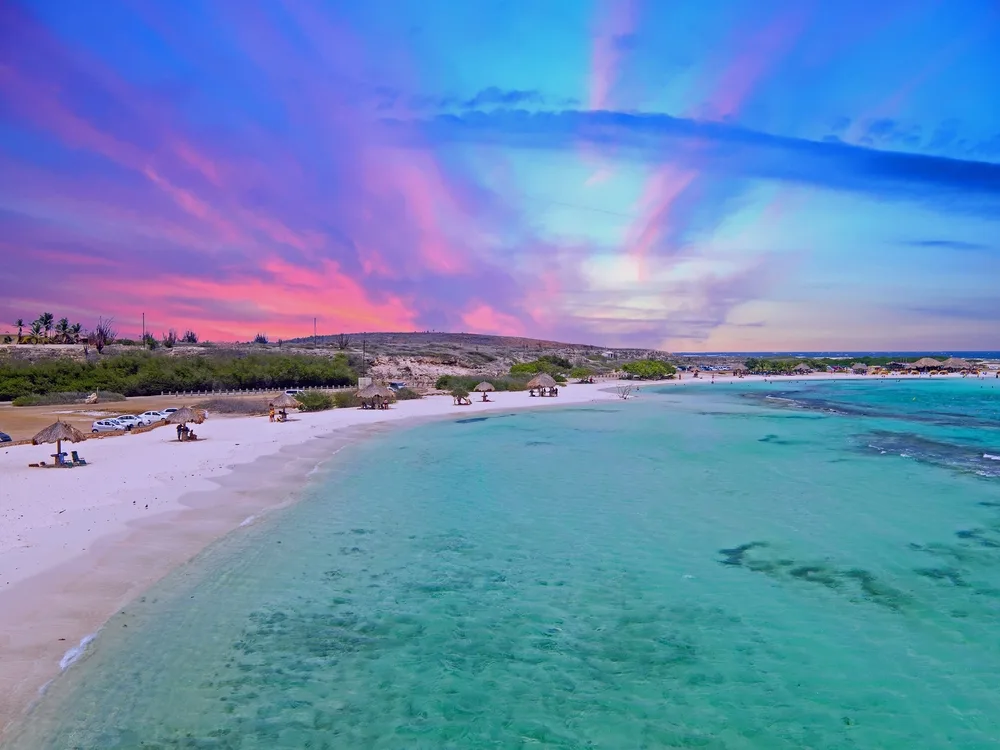
Steve Photography/Shutterstock
With year-round trade winds from the Eastern Caribbean, Aruba is particularly nice to visit and always feels a bit cooler with a constant ocean breeze. It’s also one of the safest Caribbean islands to visit with very low levels of crime.
Aruba is part of the Netherlands, located in the southern Caribbean Sea and known for its beautiful beaches and excellent options for dining, shopping, and hotels. The weather here is sublime and a strong infrastructure can make it a convenient and fun place to visit.
Locals and seasoned travelers describe it as arid and desert-like. You’ll find cacti and imported palm trees here instead of lush hillsides and tropical flowers. The safety of Aruba makes it one of our favorite Caribbean islands to visit.
Tourists don’t often witness or become victims of crime in Aruba, making it easier to let your guard down and enjoy your visit while still taking normal precautions. Some of the more common crimes are property-related and non-violent, like:
- Petty theft/larceny
- Vehicle break-ins
- Burglary
Theft from pickpocketing on busy streets and beaches to purse-snatching and car break-ins when valuables inside are visible account for many of the reported crimes in Aruba.
The U.S. State Department (which has a safe level 1 travel advisory for Aruba) advises that you can protect yourself against these crimes by leaving your valuables at home or in a safe and locking car and hotel room doors.
Violent crime does occur, though rarely, in some parts of Aruba, like the San Nicolas district at night. Robbery, rape, and homicide are always possible safety risks wherever you travel, but Aruba’s most recent data comes from 2014 and noted just 2 homicides that year.
Aruba is blessedly located outside of the Caribbean hurricane belt, insulating the island from storms and providing a safe haven if you plan on visiting during the region’s usual hurricane season between June and November.
Read Next: The Best Time to Travel to Aruba in 2025
7. St. Lucia
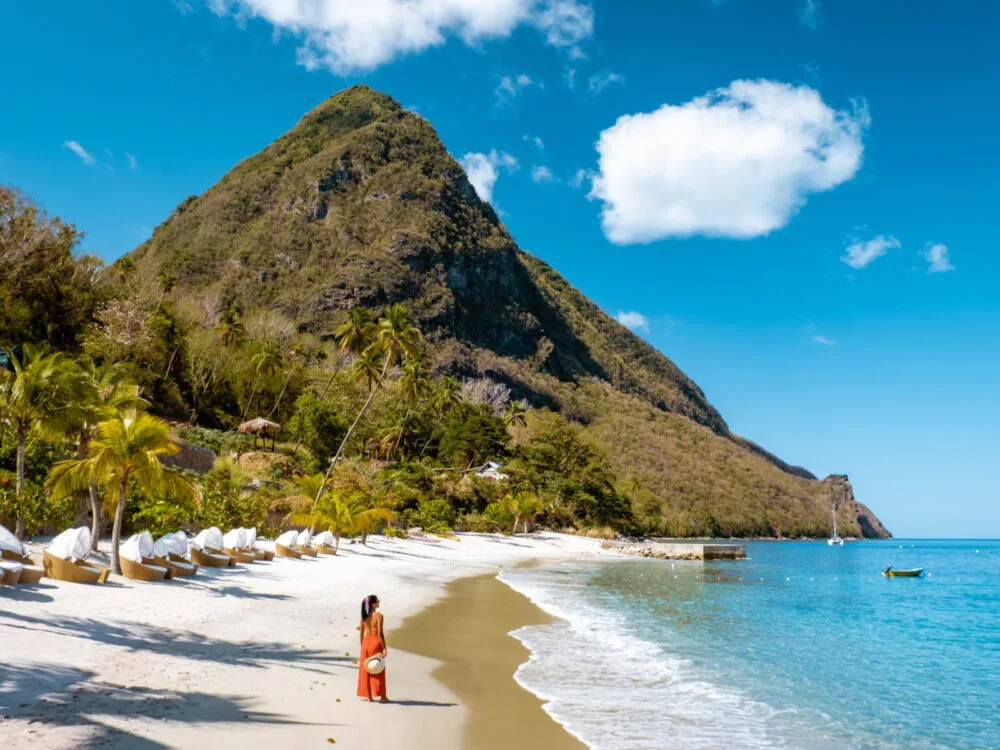
Fokke Baarssen/Shutterstock
St. Lucia is known as one of the Caribbean’s safest islands to visit and stands out as one of the most lush and tropical destinations in the region with sunny shores, verdant mountains, tropical rainforests and gardens, abundant wildlife, vast plantations, and healing mineral springs.
People flock to St. Lucia because it’s a safe, low-crime island that offers the best of the Caribbean with laid-back island vibes and all the adventure and relaxation you could want from your tropical getaway.
Crime is low across the island, with the U.S. State Department issuing a level 1 advisory due to the low crime rates and noting that tourists are not singled out by criminals here. Instead, the most common crimes are non-violent crimes of opportunity, like:
- Petty larceny
- Burglary
- Vehicle break-ins
Spots frequented by tourists have a higher incidence of these types of non-violent crimes simply because that’s where criminals have easier access to valuables (the places where tourists are enjoying themselves unaware).
But taking simple precautions on your trip, like leaving valuables locked up or at home, staying alert when you’re out in public, and ensuring your personal property is secured while walking or at the beach, can help you avoid the risk of these crimes while you’re enjoying St. Lucia.
Violent crimes do occur in St. Lucia, but at much lower rates than non-violent crimes. Homicide, robbery, and sexual assault can occur on the island, but generally don’t affect tourists and happen between locals who know each other.
There was an unprecedented jump in St. Lucia homicide numbers in 2023, but police found that most of these murders were gang-related, the result of altercations between individuals who knew each other, and domestic violence. None of these pose a specific threat for tourists.
Hurricanes can be a safety risk when you go to St. Lucia, but many hurricanes in the region pass by the island and move north without making landfall.
Still, Hurricanes like Tomas and Elsa have caused widespread damage here in the past, so it’s always worth keeping an eye on the forecast and potentially planning a visit outside of the June-November hurricane season to stay safe.
Read Next: The Best and Worst Times to Visit St. Lucia
Ready to Book?
Unlock Exclusive Discounts on Expedia.com!
Got Travel Insurance?
Protect yourself for unexpected interruptions.
Compare Plans We may be compensated when you book after clicking on one of our links.Travel Is Not Risk-Free
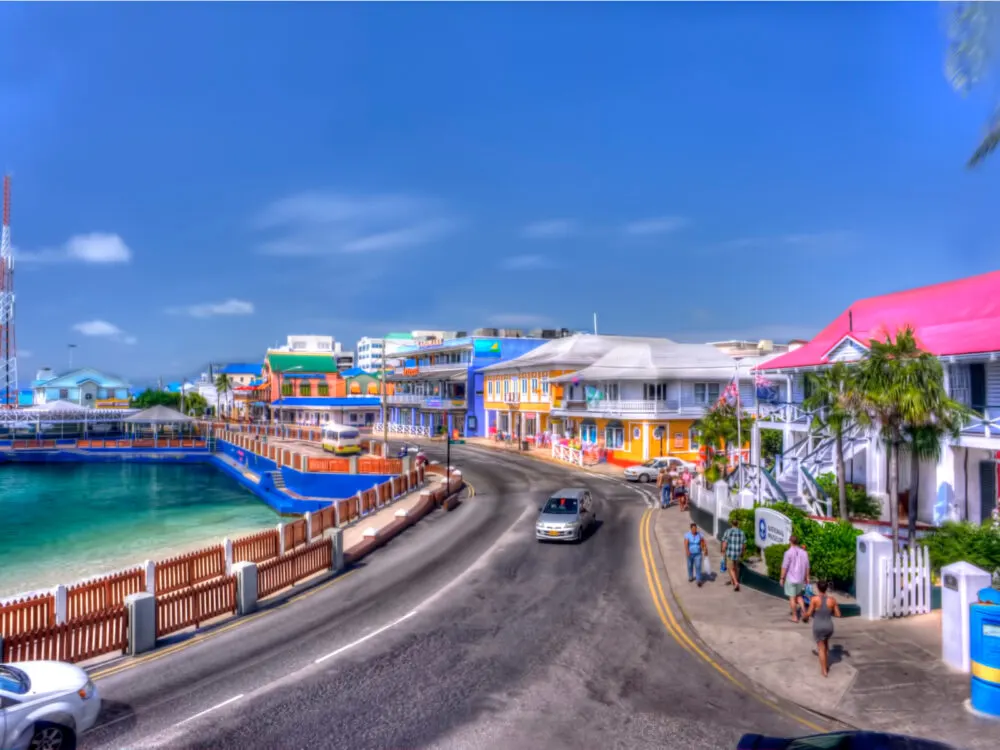
Daniel Friend/Shutterstock
While this world is full of wonder, amazing places, and a lot of good people, it can also be a dangerous place. That’s true when you’re at home or traveling to new places. The Caribbean is no exception, and even the safest islands in this region still come with their own safety and security risks for travelers.
The key is staying aware of the potential risks and doing what you can to mitigate them. If you ignore the possibility of crime and are determined to relax and enjoy your vacation without taking precautions, you open yourself up to crime and increase your chances of being victimized in some way (non-violent or violent).
Taking the proper precautions will make you safer and feel more secure while you’re vacationing in the Caribbean (or anywhere, for that matter). Here are some of the things you can do to help keep you, your traveling crew, and your belongings safe.
- Leave valuables at home or secure them. If you can’t leave your expensive watch or diamond ring at home, secure it in a hotel room safe and don’t display pricey items or large amounts of cash in public, which can make you a thief’s target.
- Stick with a group, especially at night. If you’re traveling alone, don’t go out at night unless you’re in a resort area or are going to a club or restaurant very close to your hotel. Stick to well-lit areas at night.
- Say no to unmarked taxis. Only get into marked taxis that you can verify as belonging to a legitimate company. Strangers offering rides in unmarked cars can rope you into taxi scams, charging more than the normal rate or bringing you to unfamiliar locations where you could be at risk.
- Keep your head on a swivel. The purpose of your vacation may be to relax, but don’t let it make you oblivious. Keep your eyes open and stay alert and present so you won’t be taken off-guard by crime or someone entering your personal space.
- Keep your money and ID somewhere in front of you. Backpacks, purses, and back pockets are popular places to store these items, but they’re more easily targeted by criminals who can walk close behind you and quickly pick your pocket or cut a bag strap to get access to these items.
- Drink with caution. You shouldn’t become inebriated to the point that you’re unable to function properly or maintain awareness when you’re vacationing. Keep an eye on any open drink the entire time to prevent it from being drugged without your knowledge and don’t accept drinks from strangers.
Things to Consider
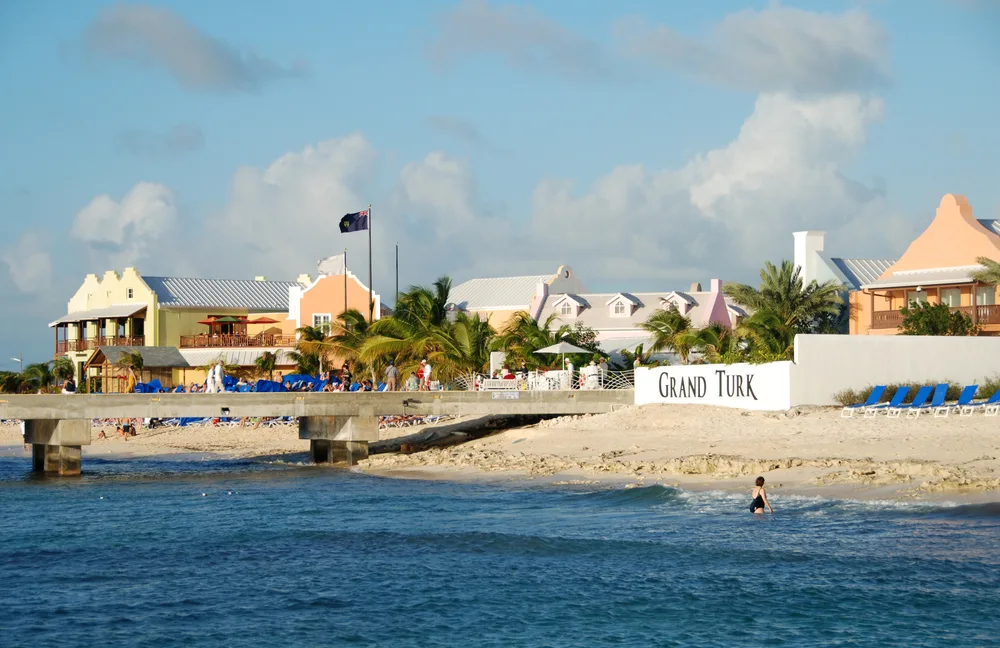
Ivan Cholakov/Shutterstock
Staying safe in the Caribbean can be as simple as planning a trip to one of the safest islands and taking note of the travel safety tips we shared above. Keep the following things in mind to help make the most of your trip!
- Get familiar with local laws. We’ve heard about tourists in the Bahamas who were stopped and detained for under-reporting the amount of ammunition they were carrying, travelers in Turks and Caicos who brought a firearm without knowing it was illegal to possess, and others who brought cannabis or controlled substances to a Caribbean island and faced jail time. Know the local laws so you can follow them and avoid getting yourself into trouble abroad.
- Get travel insurance for your trip. Even if the forecast shows the weather should be nice for your visit or there aren’t usually storms that time of year, it’s worth getting travel insurance. If illness, personal emergencies, or severe weather risks derail your trip plans, you’ll be able to get a percentage or all of the money back for your trip with a good travel insurance plan.
- Do some research on your resort or hotel. Accommodations are good at making themselves look wonderful online, showing the best photos and sometimes cherry-picked (or fake) reviews that praise the establishment’s rooms, cleanliness, proximity to attractions, and more. Doing some research by reading Booking.com, TripAdvisor, and even Reddit reviews you can find for your hotel or resort can help you get a clearer picture of the truth before you go.
Frequently Asked Questions
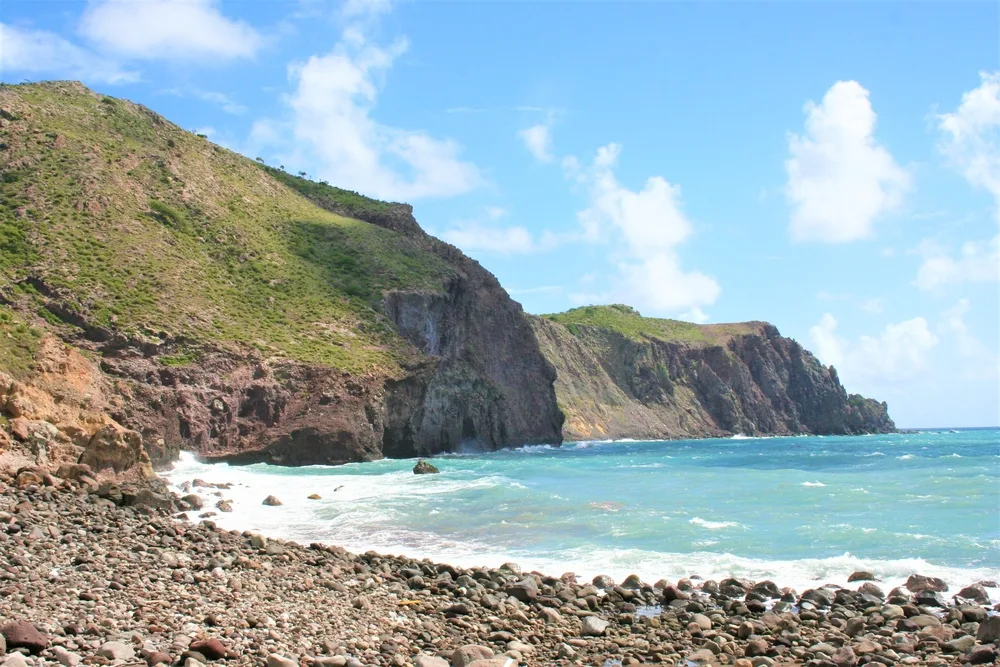
t.m. urban/Shutterstock
Wondering what else you need to know about the safest Caribbean islands to visit? Take a look at the most frequently asked questions below to learn more.
What is the safest Caribbean island?
The safest Caribbean island may be a tie between Anguilla and St. Barts (Saint Barthélemy). Both boast very low crime rates with most crimes that do occur being non-violent, like petty theft and sale of counterfeit goods. Police actively patrol these islands, providing a comforting presence that deters criminal behavior.
Both Anguilla and St. Barts have a level 1 travel advisory from the U.S. State Department, meaning travelers should feel safe and exercise normal precautions when visiting. Hurricanes and severe weather can pose a risk, but these storms rarely make landfall and very rarely result in casualties or damage.
Is the Bahamas or Caribbean safer?
The Caribbean region as a whole is safer than the Bahamas alone, but only because of higher crime rates in Nassau and Freeport. These two areas see more crime (non-violent and violent) that rarely targets tourists, but can make traveling conditions less safe. There’s a level 2 travel advisory from the U.S. State Department for the Bahamas for this reason.
If you want to visit the Bahamas, the Abacos Islands are the safest part to visit in the Family Islands. The crime rates here are very low and the difference between these islands and parts of Nassau and Freeport are night and day.
What is the cheapest and safest Caribbean island to live on?
The cheapest and safest Caribbean island to live on is likely St. Lucia. St. Lucia’s cost of living is lower than many other Caribbean islands, and it also ranks among the 7 safest Caribbean islands to visit or live on.
We found apartments and homes for rent around $700-$900/month in Castries, St. Lucia and grocery costs are generally lower with many fresh produce options available at low costs. With the low crime rates and homes/apartments available for different budget ranges, St. Lucia may be the safest and cheapest island to live on in the Caribbean.
Which Caribbean island has the highest crime rate?
Haiti is the Caribbean island with the highest crime rate overall. Violent crimes are much more common in Haiti and the U.S. State Department has issued a level 4 travel advisory for the country, saying “do not travel.” The U.N. reported that Haiti doubled its past homicide number in 2023 with 4,789 murders happening in Haiti during the year. There were 83% more kidnappings in the country during 2023 as well with nearly 3,000 victims.
What Caribbean islands to avoid?
Avoid visiting unsafe Caribbean islands with high crime rates and ongoing civil unrest, like Haiti, Jamaica, and Trinidad and Tobago. Each of these places have travel advisories from the U.S. government telling travelers to reconsider travel or avoid traveling altogether.
While there may be safe parts of these islands, there is enough crime and/or unrest occurring to cause the U.S. State Department to issue level 3 (Jamaica and Trinidad) and 4 (Haiti) travel advisories for these islands, making them generally unsafe to visit for now.
Summing Up: What Are the Safest Islands in the Caribbean?
| 🥂 Safest Luxury Island | St. Barts |
| 🗓️ Least Busy Island | Anguilla |
| 👮 Strictest Gun Laws | The Cayman Islands |
| 🚤 Most Popular | The Virgin Islands |
The Caribbean is still a sunny, tropical refuge for a care-free getaway when you head to one of the safest islands in the region. From Anguilla and St. Barts to the peaceful Abacos Islands in the Bahamas and beautiful St. Lucia, you’ll find several idyllic islands to spend a worry-free vacation here.
Be smart and don’t overlook the possibility of theft or petty crime when you travel, keeping your belongings secured and in your sight. Stay in well-populated areas where there are lots of tourists around and keep your wits about you (even if you hit the nightclubs).
If you’re headed to an island that regularly finds itself in the path of a hurricane, try to visit outside of the riskiest months (usually June to November). Going somewhere remote with no international airport? Understand you may need to be airlifted or wait to reach a hospital in case of a medical emergency.
By taking the right precautions and planning your trip to one of the Caribbean’s safest islands, you’ll be able to enjoy your time in the sun and sand without worry or concern. The Caribbean is one of our favorite regions for a tropical getaway, so do your research before you go to find the safest place.
Once you’re there, your only concern will be finding the perfect spot to plop down your towel and soak up the sun!



